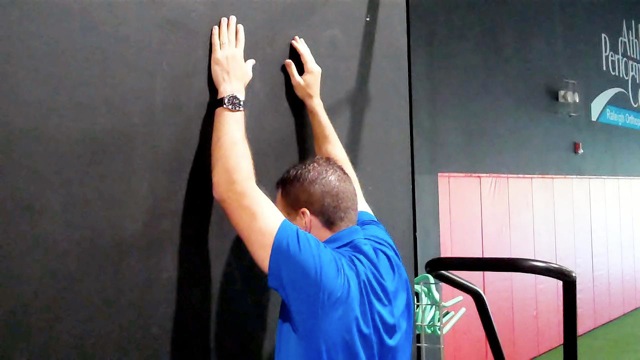
As I mentioned in the previous two columns, impaired movement of the scapula places more stress on the glenohumeral joint. Dysfunctional movement is common with shoulder pain and impingement. Another dysfunction you may encounter is a downwardly rotated scapula.
If upward rotation is limited, a client will display excessive shoulder flexion above 90 degrees when the humerus is in maximal internal rotation. Typically, a person will have minimal flexion beyond 90 degrees if the scapula is moving properly.
Upward rotation of the scapula is the result of a force couple between the upper and lower trap along with the serratus anterior. If any of these muscles are weak, rotation can be limited and overpowered by the rhomboids and levator scapulae muscles (both downward rotators). This pattern of muscle dominance is common.
Additionally, tightness in the rhomboids, levator scapulae, pec minor or latissimus can also restrict normal mobility. It is probably safe to assume stretching of the chest and lats would be helpful, but it is critical to encourage the proper muscle firing patterns in the traps and serratus anterior as well.
This exercise will focus on just that using a nontraditional form of shrugs.
Execution: Begin standing facing a wall. Slowly slide (or inch) the arms up the wall. Once you pass 90 degrees of shoulder flexion begin to actively shrug the shoulders as you move the arms up along the wall in small increments. As you reach the full available range of flexion, perform a series of 10 shrugs and then relax and lower the arms down. Repeat this cycle for 2-3 sets.
If upward rotation is limited, a client will display excessive shoulder flexion above 90 degrees when the humerus is in maximal internal rotation. Typically, a person will have minimal flexion beyond 90 degrees if the scapula is moving properly.
Upward rotation of the scapula is the result of a force couple between the upper and lower trap along with the serratus anterior. If any of these muscles are weak, rotation can be limited and overpowered by the rhomboids and levator scapulae muscles (both downward rotators). This pattern of muscle dominance is common.
Additionally, tightness in the rhomboids, levator scapulae, pec minor or latissimus can also restrict normal mobility. It is probably safe to assume stretching of the chest and lats would be helpful, but it is critical to encourage the proper muscle firing patterns in the traps and serratus anterior as well.
This exercise will focus on just that using a nontraditional form of shrugs.
Execution: Begin standing facing a wall. Slowly slide (or inch) the arms up the wall. Once you pass 90 degrees of shoulder flexion begin to actively shrug the shoulders as you move the arms up along the wall in small increments. As you reach the full available range of flexion, perform a series of 10 shrugs and then relax and lower the arms down. Repeat this cycle for 2-3 sets.
 |  |
Application: The exercise is designed to encourage upward rotation in a more functional manner as opposed to traditional shrugs with the arms at the side. While I am not opposed to traditional shrugs with little or no weight for basic elevation, this position generally tends to activate the rhomboids and levator scapulae which is not desired given their natural dominance pattern.
The wall slide shrugs should not create any pain or discomfort. However, they may feel awkward particularly if the client has a faulty muscle activation pattern. As muscle tightness resolves and strength improves, clients should gain more mobility and optimal shoulder function.
Brian Schiff, PT, CSCS, is a licensed physical therapist, respected author and fitness professional. Currently, he serves as the supervisor at the Athletic Performance Center in Raleigh, NC. Brian presents nationally at several professional conferences and seminars on injury prevention, rehab and sport-specific training. For more cutting edge training information, subscribe to his monthly Training & Sports Medicine Update at www.BrianSchiff.com.
The wall slide shrugs should not create any pain or discomfort. However, they may feel awkward particularly if the client has a faulty muscle activation pattern. As muscle tightness resolves and strength improves, clients should gain more mobility and optimal shoulder function.
Brian Schiff, PT, CSCS, is a licensed physical therapist, respected author and fitness professional. Currently, he serves as the supervisor at the Athletic Performance Center in Raleigh, NC. Brian presents nationally at several professional conferences and seminars on injury prevention, rehab and sport-specific training. For more cutting edge training information, subscribe to his monthly Training & Sports Medicine Update at www.BrianSchiff.com.

















